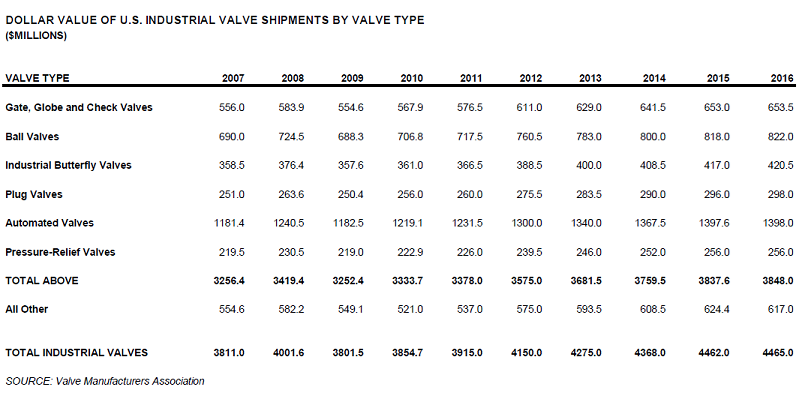VMA Sees Limited Valve Shipment Growth for 2017
After a year of little growth in 2016, U.S. valve shipments for 2017 are forecast to gain ground: about 2% for the year.
#VMAnews
“The 2% growth for this year is similar to what has happened since we recovered from the crash—slow and steady gains,” said VMA President Bill Sandler. “We peaked in 2008 with about $4.0 billion, and fell off a bit from 2009-2011, but have made strong gains each year since 2012; now we’re almost $560 million above where we were before,” he added. Although the share of valve shipments that are exports has been steadily growing the last few years, that market will remain flat at about $955 million in 2017, the same as 2016. Domestic shipments, on the other hand, will gain some ground this year: $3.594 billion compared to 2016’s $3.510.
Sandler also pointed out that better business in 2016 left VMA members in a more optimistic mood by the end of the year. A monthly survey showed that members’ moods had gone from 50% neutral and about 16% optimistic or very optimistic in July 2016 to 45.5% neutral and more than 54% optimistic or very optimistic by December 2016. The executives who answer that survey also projected more orders booked going into 2017: more than 77% said they’d be greater or equal to the previous quarter compared to about 55% who said greater or equal in July 2016.
The forecast for 2017 can be attributed to gains in water/wastewater and in petroleum refining as well as slight gains in the co-generation, gas distribution, iron and steel markets. Meanwhile, a few other industries won’t fare so well, including power, oil and gas transmission, chemical, and construction, which will see the greatest drops, though none are significant.
Even though the chemical industry slipped a bit, it remains the end-user category that has the largest share of valve shipments at 18.4% of the total. Close behind that share, however, is water/wastewater, which now constitutes 18.1% of the total (that sector had 17.8% of the market last year while chemical had 18.7%.) The other markets with large shares include petroleum refining (11.9% compared to about 11.1% last year), power generation (11.8%, which slipped from 12% last year) and petroleum production (which remained level at 10.5% of the market). Commercial construction, which received credit for valve shipment growth between 2015 and 2016, slipped from 5% last year to 4.5% this year.
As far as valve types, automated valves continue to grow in use and are the most-often used type of valve, climbing by about $281 million in shipments during the last 10 years. All types of valves tracked by VMA rose by about $762 million over that decade.
Genilee Parente is managing editor of VALVE Magazine.
RELATED CONTENT
-
ValvTechnologies and Severn Form Strategic Partnership
ValvTechnologies and Severn Glocon have reached a partnership agreement that will see collaboration between two of the world’s leading engineering and manufacturing companies specializing in innovative, high-end, severe-service valves.
-
Recycling Foreign Metals: Buyer Beware
The North American steel-making industry, with its historic record of quality control, is no longer the world’s top producer.
-
Erosive Pulp & Paper Systems Require Proper Valve Selection
As new recycled paper plants are being built for the first time in decades, not only do paper companies have opportunities to grow revenue but so do service suppliers such as valve companies.












 Unloading large gate valve.jpg;maxWidth=214)